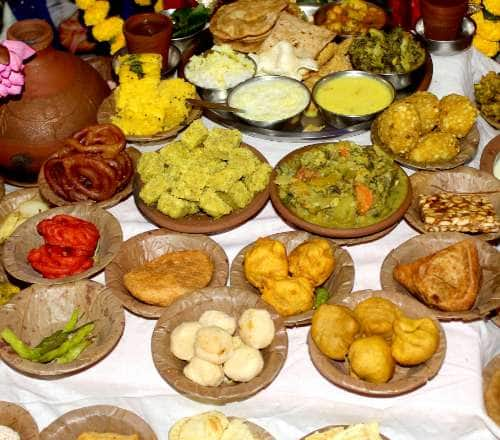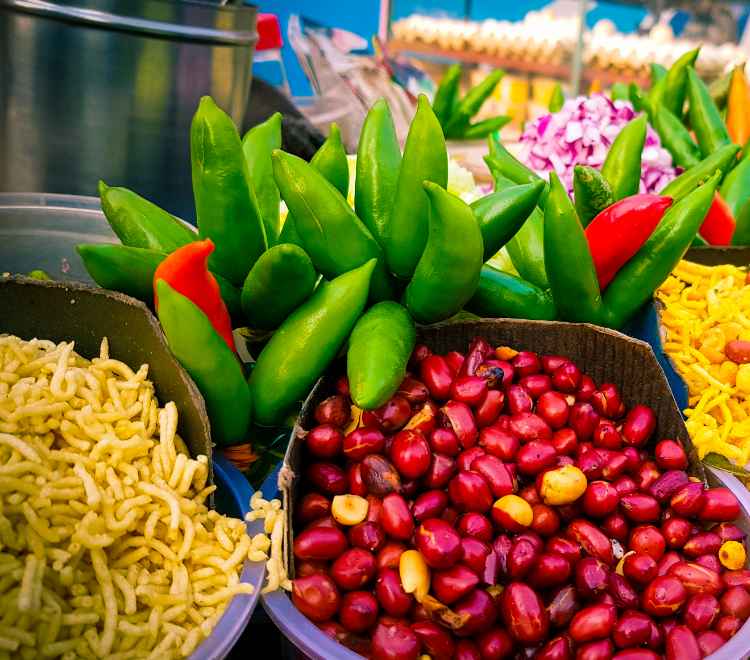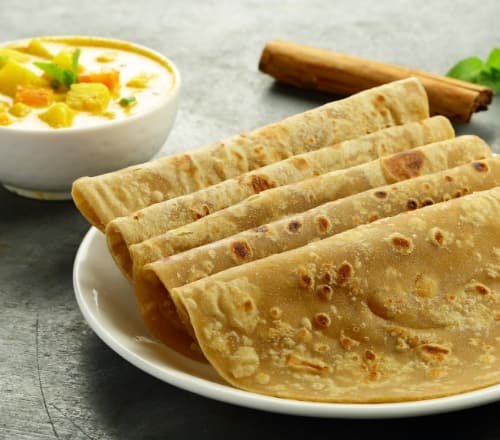Stay logged in to proceed with bookings, orders and offers.
On changing the terminal, you will loose items in your cart. Are you sure you want to change your terminal?
Explore Bhujua Bazaar, relish in the aroma, and sample bhujias by the fistful from every shop in this foodie pilgrimage.
My nose started working overtime as I entered the lanes of the famous Bhujia Bazar in Bikaner. The air was full of the aroma of deep frying and spices. We made ourselves comfortable on a stool in the bazaar and sipped hot tea in a terracotta cup. However, even the fragrance of the cardamom-flavoured tea couldn’t stop the intensely strong spicy aroma in the air from entering my senses. The fragrance of freshly-fried bhujias coming from the hole-in-the-wall shops was too much to resist. "Your nose is not blocked because of a common cold," said my friend Daulat ji, a local of Bikaner, who advised me to cherish the aroma of freshly fried bhujias.
Bhujia is a traditional snack eaten with almost everything and adds life to every food item. People of Bikaner savour this regional food throughout the day, be it the poori sabzi for breakfast, lunch, evening tea, or dinner. It is a tradition to serve bhujia and papad with every meal in Rajasthan—bhujia along with the main food and papad at the end of the meal. Bhujia is a great mood changer. You might be involved in any situation, be it a bad day at work, bad school results, or you have ample of time to pass, just pop a fistful of bhujia into your mouth. With a snap of a finger, everything feels cheerful!
While walking in the bazaar, an incident from my childhood flashed through my mind. From my routine shopping visits to the famous Burra Bazaar, a.k.a. Kalakar Street in Kolkata, with my mother, I vaguely remember a halwai sitting on a wooden platform skimming long thin noodles out of a yellow-coloured dough made of chickpea flour (besan) and a lot of other ingredients. He used to press the dough through a wheel-sized perforated ladle and deep fry the thin noodles in a massive wok full of vegetable oil till they became crispy and attained their signature golden hue. If my information is correct, this vendor was later instrumental in setting up big business dealings in various snacks like bhujias, and other sweets and savouries from Rajasthan.
Continuing our journey, Daulat ji graciously served me a plate of piping hot bhujias, urging me to taste them. I eagerly indulged in the delectable snack, savouring the flavours. He emphasised the importance of embracing the spirit of a true Rajasthani and enjoying my trip to Bikaner like a proud Bikaneri would. We kept exploring the Bhujia Bazaar as Daulat ji spoke more about Bikaner. I was not paying attention as the aroma of freshly fried bhujia was making me hungry. As I walked on, I found Bikaneries, or the locals of Bikaner, eating bhujias and other regional foods like kachoris, gathiyas, etc, and a lot of sugar-heavy dishes like laddoos and jalebi everywhere.
When we say tea, the first thing that comes to our mind is Darjeeling or Assam. Similarly, the mention of saffron immediately takes us to beautiful Kashmir. It’s the same with Bhujia—whenever it's mentioned, the visuals of Bikaner flash in front of us. The credit for introducing bhujia goes to Maharaja Shri Dungar Singh in 1877. The people of Bikaner proudly own bhujia as an indigenous creation of their town. Bhujia has put Bikaner on the world map of amazing foods. The marketplace, aptly named the Bhujia Bazaar, is famous for its wide variety of bhujia brands and flavours and the traditional hole-in-the-wall shops.
There are a few special features of the market. The market is home to several famous bhujia brands, such as Haldiram's and Shri Krishna, who have been in business for several generations. You get a wide range of bhujia flavours, including spicy, sweet, and savoury varieties. The market is known for its traditional atmosphere, with vendors selling bhujia in large earthenware pots and using traditional methods of production. The market is also famous for its other regional food such as gathiya, mathri, chakli, etc.
Even though Bhujia is produced locally all over India today, the taste of bhujia from Bikaner is different. The difference lies in the use of common as well as secret ingredients. Here, they don't use gram flour. Instead, they use ground moth beans (or the mat bean, matki, or dew bean) flour. The desert air helps add unique freshness, crispiness, and an extraordinarily long shelf life. It is not a beginner’s task to make bhujia. The dough-making in itself is a tedious job. The dough is made by mixing moth dal flour, chana dal, asafoetida, powdered cellulose, salt, red chilli powder, black pepper, cardamom, cloves, and groundnut oil in the right proportions. The dough is then deep-fried in vegetable oil after passing through a sieve till it becomes crispy and golden. In Bikaner, they also mix a fistful of good, clean desert sand into the dough. Sounds like a joke, isn’t it? That’s a fact; they mix sand in their dough, responsible for the unique taste of bhujia made in Bikaner. Also, the special sweet character of water from the deep wells in Bikaner is responsible for the unique taste of Bikaneri Bhujia.
It’s a daily ritual—the fires at the Bhujia Bazaar start at 4 am, after the dough is prepared, and soon the atmosphere is filled with a fiery haze of smoke. Wherever you see, you find bhujia experts crouched low over gigantic woks in their tiny shops over huge fires, with their hands skimming the boiling oil as they push the dough through a wheel-sized perforated ladle. For me, it was a repeat telecast of my childhood memories. The ubiquitous odour of deep frying fills up every corner of the city. For the locals though, it’s a daily routine and life keeps on moving smoothly. Everyone is busy either making, buying, or eating namkeen (savouries) or mithai (desserts). In Bikaner, bhujia is not the only snack; you also have various types of regional foods like kachoris, and over-spicy mirchi pakoras, which explode in your mouth. You are then forced to douse the fire with sweet preparations like jalebis, ghewar, and gulab jamun, etc.
Bikaner produces about 40,000 kg of bhujia every day—25,000 kg comes from factories and 15,000 kg comes from local shops and homes. More than 2.5 million people are employed in the cottage industries producing bhujia in Bikaner. Womenfolk of almost every household in Bikaner indulge lovingly in making these savouries. Because of this, Bikaneri bhujia was awarded the prestigious GI Tag in 2010. The GI Tag ensures that only registered users will be allowed to use the name of a popular product.
While walking through the lanes, Daulat ji augmented my knowledge base about Bikaner. He briefed me about this desert town, founded by Rao Bika in 1486. Bikaner attracts a large number of tourists every year. Besides being a bhujia bastion, the city is full of architectural splendour, including sandstone palaces and forts. Known for its vibrant culture, kaleidoscopic colorful costumes, and an equally diverse regional food, Bikaner, ranked as the fourth-largest in Rajasthan, has long been a magnet for visitors from far and wide. The Junagarh Fort is the most notable landmark in the city. The fort is an amalgamation of different architectural styles, including Rajput, Mughal, and Western. Apart from the Junagarh Fort, Bikaner is also home to several havelis that reflect the grandeur and opulence of the bygone era. The Rampuria Haveli and the Laxmi Niwas Palace are some of the well-known havelis in the city that offer a glimpse into the lifestyle and culture of the Rajputs. It's safe to say that Bikaner is a city that offers a perfect blend of history, culture, and cuisine.





The Adani One expressly disclaims all liability, direct and indirect, in respect to actions taken or not taken based on any or all the contents of this Blog. The Blog is an opinion of the contributor based on the collation of data from various sources and is provided only for information purpose. Adani One does not canvass, advertise, solicit, invite or induct for any product, merchandise, information, brand or any other materials mentioned in the Blog, nor does it obtain any monetary benefit from the same. Reader is advised to read and apply his/her intellect and discretion in this regard. Any Intellectual Property mentioned in this blog belongs to the rightful owner. We do not intent to claim any interest over the same.